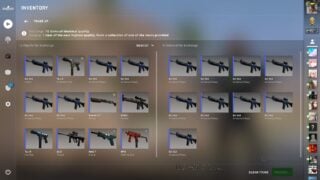Updates and collections have been a core feature of CS:GO since 2013, just a year after the game launched.
Whatever Valve’s initial plans for these cosmetic items were, it’s fair to say they’ve taken on a life of their own, spawning an entire industry based on buying, selling, and trading thousands of different skins.
While much of this industry is powered by independent sites and platforms, Valve has played its own part by introducing a system of trade up contracts. This system allows players to combine skins of the same rarity to convert them into more valuable skins.
CS2 trade up contracts are full of caveats, the most important of which is that the results of a trade up depend on the number of skins being traded.
Players frequently fail to grasp these caveats, and consequently make mistakes such as using minimal wear skins for contracts and waiting for Factory New to be released.
Read on to learn how you can use a trade up calculator for CS:GO to avoid these pitfalls and others.
How a CS2 Trade Up Contract Works
Let’s assume you’ve got ten skins of the same rarity in your inventory and you trade them up. In return, you’ll receive two or three random skins of significantly higher rarity.
Each skin comes has its own drop percentage, with higher quality items typically having lower drop rates. A relatively mediocre skin might have a drop rate of 80%, whereas a high quality one might have a rate of just 20%.
There are tons of other factors at play, but the ones you really need to know about are wearing ratings, float values, and collection requirements.
The wear rating of an item is its level of wear – that is, how scuffed and battered it looks. The float value is determined by the wear rating. A cleaner, more pristine skin typically has a lower float value than one with a few scars.
Float values range from Factory New to Battle Scarred.
Collection requirements, meanwhile, are the restrictions placed on every trade in terms of the collection the skins belong to. For instance, it’s not possible to include skins from the Anubis Collection and the Recoil Collection in the same trade.
You can read more about float values, wearing ratings, collection requirements, and more right here.
Using a Trade Up Calculator
While the outcome of a trade is always partly a matter of chance, you can use mathematics to ensure that you’re always playing the odds.
And by mathematics, we mean calculators – because who has the time for working stuff out?
Probability is a complicated subject, and it’s easy to get it wrong, losing money in the process. To avoid this, we strongly recommend taking advantage of one of the many third party trade up calculators that are available online.
To find a trade up calculator, all you need to do is Google those words. The top result is usually the best – which means it works with CS2s database to calculate drop rates with complete accuracy.
Using this information, a trade up calculator actually simulates the trade you’re proposing to carry out to let you know what the probable outcome is, along with percentage likelihoods for each skin.
If you then open up CS2 and execute the same trade, you should see more or less the same results.
How to Use a Trade Up Calculator
So how do you actually use a trade up calculator? More easily than you might think.
Start by finding a reliable and reputable simulator – for our purposes, we heartily recommend CSFloat.
The trade calculator is easy to spot. In this section, you can search for skins by clicking on ‘Search Items’. Clicking on a skin transfers it to the menu on the left, and there are ten empty slots in total.
Before running your calculation, you can adjust the wear rating in the ‘Float Value’ section of each skin.
And that’s pretty much it. By carrying out these simple steps you can go into any trade fully informed about the likely outcome, massively reducing your risk of making a bad trade and throwing away precious currency.
Browser Extensions and Other Tools
As if that set of instructions wasn’t simple enough, there are tools that make trade up calculations even more convenient and straightforward.
CSFloat Market Checker, for instance, is a completely free tool that you can install on Chrome or Opera as an extension. After logging into Steam via the website, you’ll be able to search for thousands of skins at the click of a button.
More importantly, you’ll be able to see at a glance which ones trades are likely to be the most profitable, and which ones you should avoid.
Whatever your budget, a tool like CSFloat Market Checker can help you get the most out of your CS2 trade ups.
And that can help you get the most out of the game.
The post Trade Up Calculator – CS2 Contracts Guide appeared first on Gamezebo.

No responses yet